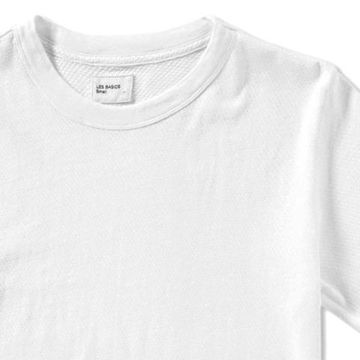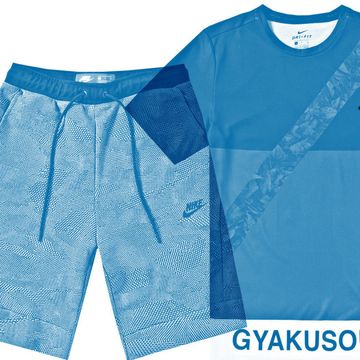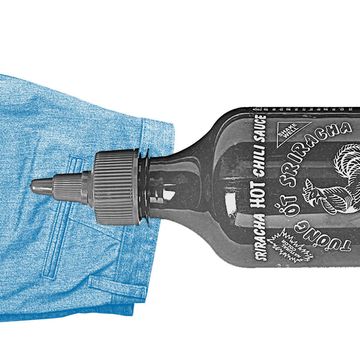Jolie Kerr is a cleaning expert and advice columnist. She'll be here every week helping to answer your filthiest questions, and once a month she'll help Esquire staffers sort out their most vexing cleaning issues. Are you dirty? Email her. Are you still dirty? Subscribe to Ask a Clean Person: The Podcast on Acast, iTunes, or Stitcher, and like Ask a Clean Person on Facebook.
Is there a cheat sheet to knowing which dry clean only clothes would *probably* be fine if you just wash them like your other clothes? — Sammy Nickalls, Nights and Weekend Editor
There is not, Dear Sammy! But there's going to be, because I'm going to make you one.
The beauty of this question is that it comes right on the heels of our very first Esquire staffer question about how to spare yourself a trip to the dry cleaner by washing dress shirts at home. I closed out that column by touching on the notion of using fabric content to inform laundering choices. "This topic," I wrote, "deserves its own column, and I definitely have it on the edit schedule, but since we're here talking about dry cleaning, I think it's worth a detour to talk about care tags, and what to do with the information you can find on them."
And so here we are, giving this topic its own column. Since you asked for a cheat sheet, I'm gonna do most of this in bullet form.
Understanding Fabric Content Will Set You Free
If you've read the column on laundering dress shirts at home, you already have an inkling of what's to come, but as a refresher: Don't bother fooling with those inscrutable fabric care runes that show up on care tags. Do, however, take the time to seek out one piece of information that can be found within: the fabric content.
Once you have that information, you can cross-reference this cheat sheet on the nature of different textiles vis-à-vis laundering.
- Cotton is a highly washable fabric but, because it's prone to shrinking, shouldn't be exposed to hot water or high-heat drying. Machine or hand wash using cold water, and air dry your fine cottons.
- Linen, like cotton, is highly washable but also quite prone to shrinking. Machine or hand wash linen using cold water, and air dry or press immediately after washing. Because linen also tends to wrinkle like a bitch (that's a technical term we use in the business) (OK fine it's not), do consider pressing linen garments straight out of the wash, in the way we talked about with your dress shirts.
- Nylon is also entirely machine washable. It is, however, likely to become quite staticky. Hanging nylon garments to air dry, however, will take care of that, since static tends to develop in the dryer.
- Polyester is totally machine washable. You'd have to work to foul up your polyester duds. Air drying, however, is always a smashing idea.
- Rayon and viscose are like mogwai, in that you should avoid exposing both types of fabric to water. Always dry clean your rayon and viscose clothes.
- Silk is beautiful and temperamental, highly prone to color loss, and susceptible to water staining. I wouldn't blame you one bit if you outsourced its care. But if you would like to take matters into your own hands, silk can be hand washed in cool water, using a silk detergent like Le Blanc Silk & Lingerie Wash. The important thing to know about silk is that it doesn't love prolonged exposure to water, so your hand washing operation ought to be a quick one, no more than five minutes from start to finish.
- Spandex is machine washable, but it hates chlorine bleach.
- Wool (inc. cashmere, angora, mohair, etc.) fibers are likely to felt—that is, become matted and shrink—when washed. There are two primary reasons that felting occurs: agitation and exposure to fluctuating water temperatures. Given that, it's best to hand wash, rather than machine wash, woolens in cool water. For way, way more on washing and caring for wool, check out my guide to sweater care.
A quick note on blends: When in doubt, follow the instructions for the more temperamental fabric. So, if you've got an item of clothing that's cotton and Spandex, follow the rules for Spandex.
When to Outsource the Work
I'm fond of saying that, when it comes to cleaning or fabric care, it's almost more important to know what not to do than it is to know what to do. With that, here's a rundown of garment types—and the afflictions that may mar their otherwise lovely appearance—that should generally be sent out for professional or specialty cleaning.
- If the garment is embellished, i.e. has beading, sequins, intricate embroidery, etc.
- If the garment's fabric content includes rayon or viscose.
- If there are stubborn or mystery stains on silk.
- If the origin of the stain is unknown and/or has set in over time.
- If the garment is bulky, like a wool winter coat.
What to Know About Hand vs. Machine Washing
When it comes to laundering dry clean only garments at home, your best bet will always be to hand wash. But machine washing is also an option, especially for less fussy fabrics like cotton or polyester. If you do opt to machine-wash, here are a few things to do to make the experience as gentle as possible for your most special clothes.
- Water temperature: Opt for cold water.
- Cycle length: If your washing machine gives you the option to set the cycle length, i.e. the amount of time during which the machine will run, opt for the shortest cycle.
- Cycle speed: Cycle speed, i.e. the speed and force at which the drum moves during the wash and spin cycles, goes by different names on different machines. Most commonly, you'll see cycle speed expressed as "regular" (fast wash and spin cycles), "permanent press" (fast wash, slow spin), and "delicate" (slow wash and spin), or as "fast/fast," "fast/slow," and "slow/slow." "Delicate" or "slow/slow" is what you want.
- Load mix: When it comes to washing delicate garments, wash like with like and avoid mixing heavy items like towels, jeans, or sweatshirts in with fine cottons, linens, wools, or silks. Spandex and other garments with stretch in them shouldn't be washed with overly lint-y items like fleece or terrycloth.
- Drying: Air dry. Full stop.















